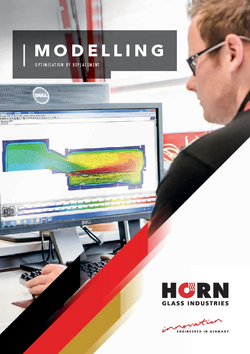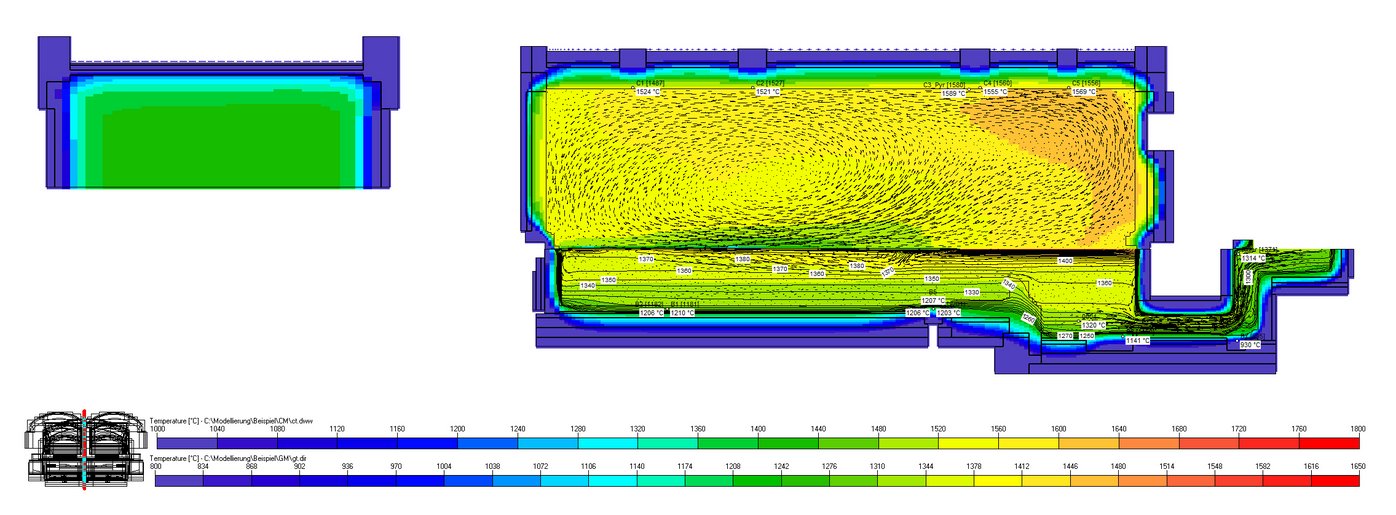This decision usually involves high investment costs and substantial effort. HORN® has all the necessary resources to determine the most important decision-making factors and relevant data within a relatively short period of time in order to support customers by finding the optimal solution quickly and purposefully.
HORN® designs are based on solid experience, comprising data analyses, characteristic values and formulas to work out a concept tailored to customer needs.
These and similar questions are difficult to answer without modelling. Moreover, modelling offers the advantage of visualising the current processes, so the problems of a glass plant can be identified and potentially increasing costs avoided.
HORN® mainly models glass melting furnaces with superstructure, all electric furnaces as well as forehearths and regenerators. Modelling is especially useful for quotations and orders if certain limits are reached with regard to the design, e.g. melting surface load, energy consumption, bath depth, and where there is a need for clarification. When a new furnace is to be constructed, HORN® models the existing furnace or a comparable furnace according to the operating data, and simulates different variations of the new furnace project. In this way HORN® can achieve comparability with the actual operating performance.
What does HORN® need? The most important information is a drawing with indication of the refractory materials, the calorific value, the glass composition, the operating data of the existing furnace as well as the concept of the new planned furnace.
As a result, the temperature distributions and the streamlines in the melt as well as in the superstructure will be visualised in several relevant 2D sections of the 3D model. Furthermore, if possible, the programme models tracers, which facilitate statements concerning residence time distribution and glass quality. Depending on the problems, further parameters such as energy consumption, flame shape, batch distribution, superstructure and bottom temperatures as well as temperatures within the glass of the different modelling cases can be compared.
The HORN® modelling is characterised in particular by its high practical relevance and authenticity.
In order to ensure practically relevant modelling, HORN® works with the operating data of selected and recently commissioned furnaces, adds measuring data and models to these operating conditions, so that the values measured in operation comply with the model. In that way, a collection of significant basic models of diverse furnace sizes, melting end loads, colours, cullet percentages, etc. can be created. The pool data can be modified by using different parameters, such as the geometry or the electric boosting system, in order to develop further regularities for the design. This procedure distinguishes HORN® from other suppliers.
Moreover, any changes in the operating performance which occur in practice should be reflected in the model, as well as in an analysis of the model simplifications in order to assess which tasks can be solved with modelling and which ones cannot.
Based on the positive effects of this realistic modelling of glass melting furnaces, which HORN® also uses for trouble-shooting and optimisation processes for the operating performance, HORN® can summarise the results of each modelling in a detailed report of the relevant data and facts, illustrated with meaningful images. A HORN® expert will discuss both the customised report and the modelling and advise customers on their HORN® project.

COOKIES
We use cookies to make it easier to use and to further improve our service.
If you have given us your consent, you can revoke it at any time in the data protection declaration.
COOKIES
Necessary
Necessary cookies help make a website usable by enabling basic functions such as page navigation and access to secure areas of the website. The website cannot function properly without these cookies.
C3 Cookie
| Name | Provider | Purpose | Expiration | Type |
|---|---|---|---|---|
| c3kie | hornglass.com | Saves the consent status of the user whether the cookie window should be displayed. | 180 days | HTTP Cookie |
Technical
Technichal cookies help to improve the user experience of the website. New functionalities will be enabled.
YouTube
| Name | Provider | Purpose | Expiration | Type |
|---|---|---|---|---|
| yt-player-headers-readable | YouTube | Used to determine the optimal video quality based on the visitor's device and network settings. | Persistent | HTML Local Storage |
| VISITOR_INFO1_LIVE | YouTube | Tries to estimate the range of users on pages with built-in YouTube videos. | 179 days | HTTP Cookie |
| YSC | YouTube | Registers a unique ID to keep statistics on which videos from YouTube the user has seen. | Session | HTTP Cookie |
| yt.innertube::nextId | YouTube | Registers a unique ID to keep statistics on which videos from YouTube the user has seen. | Persistent | HTML Local Storage |
| yt.innertube::requests | YouTube | Registers a unique ID to keep statistics on which videos from YouTube the user has seen. | Persistent | HTML Local Storage |
| ytidb::LAST_RESULT_ENTRY_KEY | YouTube | Saves the user's video player settings with embedded YouTube video. | Persistent | HTML Local Storage |
| yt-remote-cast-available | YouTube | Saves the user's video player settings with embedded YouTube video. | Session | HTML Local Storage |
| yt-remote-cast-installed | YouTube | Saves the user's video player settings with embedded YouTube video. | Session | HTML Local Storage |
| yt-remote-connected-devices | YouTube | Saves the user's video player settings with embedded YouTube video. | Persistent | HTML Local Storage |
| yt-remote-device-id | YouTube | Saves the user's video player settings with embedded YouTube video. | Persistent | HTML Local Storage |
| yt-remote-fast-check-period | YouTube | Saves the user's video player settings with embedded YouTube video. | Session | HTML Local Storage |
| yt-remote-session-app | YouTube | Saves the user's video player settings with embedded YouTube video. | Session | HTML Local Storage |
| yt-remote-session-name | YouTube | Saves the user's video player settings with embedded YouTube video. | Session | HTML Local Storage |
Advertisement
Advertisement cookies allow our advertising partners to show you ads that fit your interests.
TikTok
| Name | Provider | Purpose | Expiration | Type |
|---|---|---|---|---|
| _ttp | TikTok | Used to store a unique user ID. | 1 year | HTTP Cookie |
| Name | Provider | Purpose | Expiration | Type |
|---|---|---|---|---|
| _fbp | Used to store and track visits to websites. | 3 months | HTTP Cookie |
Statistics
Statistics cookies help website owners understand how visitors interact with websites by collecting and reporting information anonymously.
Google Tag Manager
| Name | Provider | Purpose | Expiration | Type |
|---|---|---|---|---|
| _ga | Google Tag Manager | Registers a unique ID that is used to generate statistical data on how the visitor uses the website. | 2 years | HTTP Cookie |
| _ga_ | Google Tag Manager | Collects data on how often a user visited a website, as well as data on the first and last visit. Used by Google Analytics. | 2 years | HTTP Cookie |
Microsoft Clarity
| Name | Provider | Purpose | Expiration | Type |
|---|---|---|---|---|
| _clck | Microsoft | Persists the Clarity User ID and preferences, unique to that site is attributed to the same user ID. | 1 year | HTTP Cookie |
| _clsk | Microsoft | Connects multiple page views by a user into a single Clarity session recording. | 1 year | HTTP Cookie |
| CLID | Microsoft | Identifies the first-time Clarity saw this user on any site using Clarity. | 1 year | HTTP Cookie |
| ANONCHK | Microsoft | Indicates whether MUID is transferred to ANID, a cookie used for advertising. Clarity doesn't use ANID and so this is always set to 0. | 1 year | HTTP Cookie |
| MR | Microsoft | Indicates whether to refresh MUID. | 1 year | HTTP Cookie |
| MUID | Microsoft | Identifies unique web browsers visiting Microsoft sites. These cookies are used for advertising, site analytics, and other operational purposes. | 1 year | HTTP Cookie |
| SM | Microsoft | Used in synchronizing the MUID across Microsoft domains. | 1 year | HTTP Cookie |

